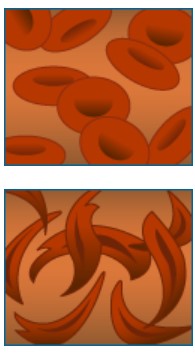A “perfect” population would not carry any deleterious genes — but as we’ve already seen, natural selection does not produce a perfect population.
We would expect natural selection to remove genes with negative effects from a population. Individuals who carry those genes would not reproduce as much, so the genes should not be passed on. And yet we see cases where this expectation is not met. For example, human populations generally carry some disease-causing genes that affect reproduction.
Why might deleterious genes exist in a population?
- They may be maintained by heterozygote advantage

Normal red blood cells (top) and sickle cells (bottom). When carrying two copies of a gene is disadvantageous, but carrying only one copy is advantageous, natural selection will not remove the gene from the population — the advantage conferred in its heterozygous state keeps the gene around. For example, the gene that causes sickle cell anemia is deleterious if you carry two copies of it. But if you only carry one copy of it and live in a place where malaria is common, the gene is advantageous because it confers resistance to malaria.
- They may not really reduce fitness
Some genetic disorders only exert their effects late in life, after reproduction has taken place. For example, the gene that causes Huntington’s disease typically does not exert its devastating effects until after a person’s prime reproductive years. Such genes will not be strongly selected against, because an organism’s fitness is determined by the genes it leaves in the next generation and not its life span. - They may be maintained by mutation
The mutation may keep arising in the population, even as selection weeds it out. For example, neurofibromatosis is a genetic disease causing tumors of the nervous system. Natural selection cannot completely eliminate the gene that causes this disease because new mutations arise relatively frequently — in perhaps 1 in 4000 gametes. - They may be maintained by gene flow
The gene may be common, and not deleterious, in a nearby habitat. If migration from the nearby population is frequent, we may observe the deleterious gene in the population of interest. For example, in places like the U.S., where malaria is not a problem, the gene that causes sickle cell anemia is strictly disadvantageous. However, in many parts of the world, the gene that causes sickle cell anemia is more common because a single copy of it confers resistance to malaria. Human migration causes this gene to be found in populations all over the world. - Natural selection may not have had time to remove them yet
The direction of selection changes as the environment changes — what was advantageous or neutral ten generations ago may be deleterious today. It is possible that some of the deleterious genes that we observe in natural populations are on their way out, but selection has not yet completely removed them. For example, although there is debate about the issue, some researchers have proposed that the relatively high frequency in European populations of the gene causing cystic fibrosis is a historical holdover from a time when cholera was more rampant in these populations. It is proposed that carrying the cystic fibrosis gene provided some resistance to cholera and so increased in frequency in earlier European populations. Now that these developed nations are no longer threatened by cholera and the selective environment has changed, natural selection may be slowly weeding the cystic fibrosis gene out of those populations.
Learn more about some of the genetic diseases discussed here:
